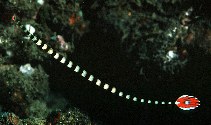| Family: |
Syngnathidae (Pipefishes and seahorses), subfamily: Nerophinae |
| Max. size: |
19 cm TL (male/unsexed) |
| Environment: |
reef-associated; marine; depth range 5 - 56 m |
| Distribution: |
Indo-Pacific: Red Sea and East Africa to Samoa, north to Japan (Ref. 559), south to Australia. |
| Diagnosis: |
Dorsal spines (total): 0-0; Dorsal soft rays (total): 20-26; Anal spines: 0-0; Anal soft rays: 4-4. Usually with one dark band crossing opercle (Ref. 4281).
Description: Characterized by alternating dark brown to reddish and white bands; caudal fin red, white-edged with central yellow or white spot; 10 caudal rays; rings 15 - 17 + 18 - 22; discontinuous superior trunk and tail ridges; inferior trunk ridge ends on anal ring; lateral trunk ridge confluent with inferior tail ridge; length of snout 1.4-1.8 in head length; depth of snout 10.6-20.8 in snout length; head length 3.7-4.6 in SL (Ref. 90102). |
| Biology: |
Adults inhabit tide pools, lagoons, and outer reef slopes. Found in caves and crevices. Ovoviviparous (Ref. 205). Feeds on small invertebrates (Ref. 89972). The male carries the eggs in a brood pouch which is found under the tail (Ref. 205). Have been reared in captivity (Ref. 35416). Solitary, pairs or in small aggregations in caves or under ledges (Ref 90102). |
| IUCN Red List Status: |
Data deficient (DD); Date assessed: 28 June 2016 Ref. (130435)
|
| Threat to humans: |
harmless |
Source and more info: www.fishbase.org. For personal, classroom, and other internal use only. Not for publication.
